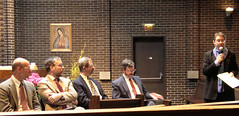Temps Trouvé
So yesterday I reconnected with Mike and Jeneane, and today I’ll pick up a couple of threads with David and Tom. All that’s lacking would be a stinging observation from the Tutor and an argument with Mike Sanders.
So to return to Tom, the challenge (he politely calls it a “quibble”) that he poses at the end of his review submits that “it’s safe to say that there are many, many features of written language that can be identified, logged, quantified, in a manner that most (one can’t say “all,” ever) people would find nothing to disagree with. We can count the “Q’s” in a poem and arrive at a total – and, pace AKMA’s pains to assure us that one never reads the same Q twice, there’s a literal identity that subtends the manifestations of that and every other member of the alphabet that cannot be elided by attending to differences such as whether the Q is in print, or handwritten, etc.” On the basis of this premise, he reminds me that “there is reason to have faith in the utility of a distinction between description — as per the Trivium — and interpretation”
My response will probably not, alas, set his mind at ease. I’m entirely comfortable distinguishing description from interpretation, and proposing examples of each that contrast sharply with one another. I’d still argue, though, that the distinction I proposed was not more durable than the consensus that backs it up. Since as Tom allows, “one can’t say ‘all,’ ever,” what do we make of the dissenters who claim that there are two “Q” in “Not Ideas about the Thing
but the Thing Itself”? Well, we can start by saying they’ wrong, but we already knew that we thought that, and so did they; that doesn’t advance our understanding of anything (even if it be true). Rather, we can learn by noting the scope and characteristics of the set of all people who believe there is but one Q in “Not Ideas. . .” and comparing them to the scope and characteristics of the set of all people who think there are two. Such comparisons, often not worth much more time than a few seconds, can justifiably issue in claims such as “As far as we’re concerned, there just plain is one Q in ’Not Ideas. . . ,” and there’ an end on’t.” or even “It’s a fact.” But where people disagree over what a fact is, we have to come back to acknowledging that our claims about facts aren’t self-authenticating; they differentiate “us” (for whom it’s a fact) from “them” (who for whatever reason, delusion, insanity, blinkered pig-ignorance, or sometimes an uncommon insight, dispute our claim). So yes, sure, there’s a difference between description and interpretation. But precisely where we want it to do some work for us, when we want to explain to some confused person that we’re describing and they’re interpreting, the distinction does us no good.
On a related note, I was emailing back and forth with David while he was preparing this morning’s post, and at the same time as he was writing “Nature is just about all joints. How we carve depends on our interests, intentions and culture,” I was emailing him the following questions:
If Everything is Miscellaneous, doesn’t that mean that taxonomies aren’t intrinsic to things? And if taxonomical tags don’t subsist in things, but they’re taxonomized based on relationships that people imagine and (by acting upon) put into practice, might one not apply the same reasoning to. . . words and meaning?
David sees a difference in the cases, a difference foretold by his qualifying “just about all joints.” Maybe after he gives his presentation, and I finalize my course proposals for Seabury’s new improved curriculum (with mostly the same courses extended to a semester each, but which require all new course proposals), we can clarify the ground we don’t share.
Continue reading “Temps Trouvé“
